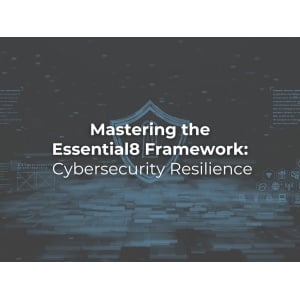During the financial year of July 2021 to June 2022, the Australian Cyber Security Centre (ACSC) received over 76,000 cybercrime reports, up from 13 per cent from the previous year.
As statistics like these have permeated the news, improving cyber security measures has moved to the top of the list for many executives and IT leaders. So, how can you discern where your organisation stands regarding your cyber security posture? How can you know where to improve?
The Essential Eight Maturity Model is one approach you can take to measure the effectiveness of your current cyber security strategy and target areas for improvement.
What is the Essential Eight?
The Essential Eight Maturity Model is a cyber security framework that guides you on improving your organisation’s cyber security posture. The ACSC designed the Essential Eight for Microsoft Windows-based internet-connected networks to protect organisations against cyber threats to these operating environments. You can apply the thinking behind the Essential Eight to other tech and operating environments, but note that you may need to adjust your cyber security strategy to account for other operating systems.
The model outlines eight essential elements of an effective cyber security program, which are:
- Application control focuses on the implementation and use of application allowlisting, patching applications, and isolating high-risk applications.
Patch applications to protect against malicious software such as viruses, malware and ransomware. It involves keeping systems up-to-date with the latest security patches to ensure they run securely. - Configure Microsoft Office macro settings to protect from malicious code that threat actors can embed in macros. The most effective way to secure macro settings is by disabling them entirely if your team do not require them. However, if macros are necessary for some tasks, you should adjust macro security settings to the highest level possible.
- User application hardening ensures that Microsoft 365 and Office applications are secure and reliable throughout their lifecycle. To meet the requirements for this point, IT will need to monitor, patch, and apply secure coding practices to ensure that applications are always up-to-date with the latest security measures and industry standards.
- Restricting administrative privileges ensures that only authorised personnel can view or modify sensitive data and settings to protect against malicious actors who may try to gain access to critical systems or data. You can reduce the risk of insider threats by reducing the number of privileged accounts.
- Patching operating systems involves timely updates and patching of software components to improve performance, reduce vulnerabilities and maintain overall system security. This process ensures that all components have the latest security patches and fixes, providing an additional layer of protection against malicious attacks.
- Multi-factor authentication (MFA) is an important security measure that makes it more difficult for threat actors to compromise user accounts. It requires users to prove their identity with something they know (a password), something they have (a phone) and/or something they are (their face or fingerprint).
- Regular backups ensure that your data is safe and secure in case of accidental or malicious loss or corruption. Regularly backing up data can mitigate the impacts of large, costly losses.
The Essential Eight Maturity Model covers four levels:
Level Zero indicates that your organisation has significant cyber security weaknesses. At this level, organisations are generally unaware of the risks they face and have a limited understanding of the importance of cyber security. There are no processes or policies, and you have allocated very few or no resources to the task.
Level One focuses on improving single security controls and identifying gaps in existing controls. At this level, organisations are beginning to recognise the importance of security and compliance. They are taking steps toward creating a secure environment for their operations and assets.
Level Two means your organisation understands security risks and actively manages and responds to them.
Level Three means you leverage automation tools to enable continuous cyber security controls and monitoring. This level emphasises a shift from manual processes to automated ones to provide more consistent and timely security measures.
How can you use the Essential Eight Maturity Model?
Now that you are across the Essential Eight Maturity Model, how exactly can it inform your practices in improving your organisation’s cyber security posture?
The Essential Eight Maturity Model guides you in assessing your current security posture, identifying areas for improvement, and prioritising actionable steps for increasing cyber security effectiveness. Evaluating these security aspects against an established framework for best practices enables you to make informed decisions about reducing your risk exposure. Additionally, this model provides a common language for discussing cyber security so that everyone involved can clearly understand the basic concepts.
Some steps that you might take in response to discovering your maturity level include:
- Application allowlisting prevents malicious applications and code from running on an operating system, as only approved software can execute.
- Minimising administrative privileges to only those who require them reduces the potential for malicious activity on a system.
- Hardening and configuring your systems to the most secure settings possible reduces the potential for exploitation of vulnerabilities and protects against various threats.
- Educating users on best practices and enforcing training requirements ensures everyone knows their roles and responsibilities regarding cyber security.
- Secure network connections with proper access control, encryption, and authentication to protect against threats.
- Regularly testing the security of systems, networks, and applications improves your ability to identify and address vulnerabilities promptly.
With careful planning and implementation, you can effectively increase your cyber security maturity level and protect your business from potential threats.
alltasksIT can improve your cyber security posture
Boosting your cyber security posture is a daunting task to undertake. If you want the best results, you should work with an experienced firm that understands the Essential Eight Maturity Model inside-out and can implement the right solution for your organisation.
As a managed cyber security services company in Australia, we deliver MFA, cyber awareness training, persistent threat detection, access control, application control and DNS filtering. Visit our Essential Eight page if you would like more information on what we can do for your organisation.






